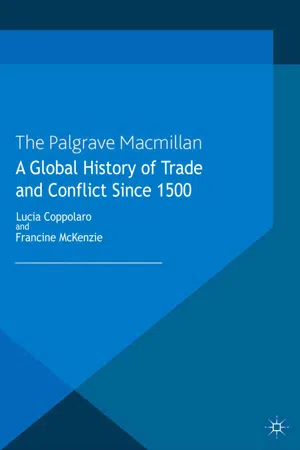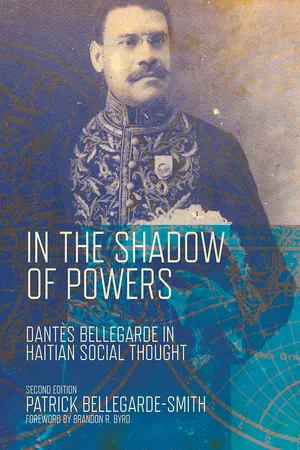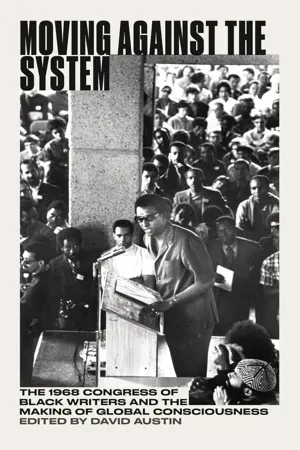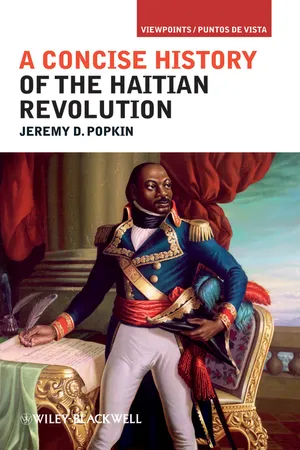History
Haitian Revolution Causes
The Haitian Revolution was fueled by a combination of social, economic, and political factors. Slavery and the harsh treatment of enslaved people, as well as the influence of the French Revolution and the desire for freedom and independence, were key causes. Additionally, the leadership of Toussaint Louverture and other revolutionary figures played a significant role in sparking and sustaining the revolution.
Written by Perlego with AI-assistance
Related key terms
9 Key excerpts on "Haitian Revolution Causes"
- eBook - ePub
The Roots and Consequences of Independence Wars
Conflicts That Changed World History
- Spencer C. Tucker(Author)
- 2018(Publication Date)
- ABC-CLIO(Publisher)
Haitian Revolution and Wars of Independence (1791–1804) CausesThe Republic of Haiti is a sovereign state on the island of Hispaniola in the Greater Antilles archipelago of the Caribbean just to the east of Cuba. Haiti shares the island with the Dominican Republic; Haiti comprises the western three-eighths of the island, while the Dominican Republic comprises the rest. Europeans first arrived in 1492 when Christopher Columbus, sailing for the Spanish Crown, stopped at the island that December, believing he had found Asia.Spain claimed possession of the island, which remained under Spanish control until the 17th century. The French established settlements in the western part of Hispaniola and on the island of Tortuga by 1659, and in the Treaty of Ryswick of 1697 that ended the War of the League of Augsburg (Nine Years’ War), Spain formally ceded to France control both of Tortuga and the western third of Hispaniola, now named Saint-Domingue.Saint-Domingue had a plantation economy based on slaves brought to the island from Africa. The island’s plantations produced coffee, cocoa, and indigo, but the main cash crop was sugarcane. The production of sugar made Saint-Domingue the most prosperous of France’s colonies and the wealthiest of all European colonies in the Caribbean. In 1789 it produced some 60 percent of the world’s coffee and 40 percent of the sugar imported by France and Britain. Under the French mercantilist system, Saint-Domingue was not permitted to develop its own industries and was forced to purchase finished goods from France, with all trade carried in French ships. Although many planters became fabulously wealthy, they also harbored resentment against the French government strictures.Haitian Revolution and Wars of Independence (1791–1804)Estimated Total Deaths, Haitian Revolution and Wars of Independence (1791–1804)*Black HaitiansFrench and British SoldiersWhite Colonists200,000 100,000 25,000 *Deaths from all causes. Scholars suspect that the majority of deaths were due to yellow fever. - L. Coppolaro, F. McKenzie, L. Coppolaro, F. McKenzie(Authors)
- 2013(Publication Date)
- Palgrave Macmillan(Publisher)
3 An Explosion of Violence: How the Haitian Revolution Rearranged the Trade Patterns of the Western Hemisphere Steven TopikHistorians in recent years have finally begun to give the Haitian Revolution of 1791–1804 the attention that it deserved as one of the first wars of national liberation and as a momentous blow against Atlantic slavery.1 That struggle demonstrated that the ideals that so marked the French Revolution, ‘liberté, égalité, fraternité’, had very different meanings – and consequences – in an overseas French colony overwhelmingly inhabited by slaves, many of whom were born in Africa. This chapter will consider that world historic event from an unusual perspective by addressing its consequences for international trade in the early nineteenth century. Was the destruction of the Haitian ‘Pearl of the Antilles’ constructive and, if so, who enjoyed the benefits? It will be argued that the colonial bloodbath that severely impacted the most precious European colony in the Caribbean had the ironic effect of diffusing and expanding tropical exports in the Americas – but not in Haiti – and amplifying mass consumption in the United States and Western Europe – but not in the Caribbean. This violent transnational war and social upheaval served as a vehicle for commercial globalization.The historiography of the Haitian RevolutionThe 13-year-long revolution that broke out in the rich French colony known as Saint Domingue, until recently had been largely ignored or treated as an aberration.2 It is not even included in R. R. Palmer’s Age of the Democratic Revolution , perhaps because of its ominous social implications and because the rebels were as much inspired by African traditions as by European ones. Latin America’s first independent country and first republic arose from a successful slave revolution – the first in the Americas – that broke out in 1791 in Saint Domingue, later known as Haiti. Perhaps because of its uniqueness, Samuel Huntington in his widely cited Clash of Civilizations? dismisses events in Haiti as marginal to the history of Western civilization because it was a ‘lone country’ that lacked ‘cultural commonality with other societies’.3- eBook - ePub
The Haitian Revolution
Capitalism, Slavery and Counter-Modernity
- Eduardo Grüner, Ramsey McGlazer(Authors)
- 2019(Publication Date)
- Polity(Publisher)
The great revolution fought by the slaves of Saint-Domingue/Haiti was the culmination, as well as the most conscious example, of this effort, this displacement of one set of objectives by another. Of course, this process was, like any such social and political process, marked by all kinds of nuances, hesitations, and contradictions, including ideological contradictions. In order to attempt to understand these, we need to ask what the situation in Haiti was like before – and just after, on the sidelines of – the world-historical event that was the Haitian Revolution. Many rebellions began as acts of desperation, more or less spontaneous expressions of resistance to the unspeakable conditions of exploitation, starvation, sadism, racism, and veritable dehumanization under which slaves lived. Others, like the marooned slaves or quilomberos who occasionally organized “guerrilla” groups that undertook to find provisions or punish their old masters for their abuses, sought to withdraw from the society of slaveholders and to “restore” an archaic order that they imagined would be perceived as quintessentially “African.” Instead, however, these fugitives’ communities were in fact new creations, fully African American, with an emphasis on the “American.” From a strict anthropological and cultural point of view, they attested to the creation of a new culture in the so-called “New World.” Again, these movements differed according to region and location, to be sure. Slaves in the Southern United States had a history that was very different from the history of slaves in the Caribbean or in Brazil, for example. In “the great country in the North,” the largest expansion of the slave regime, territorially, economically, and demographically, happened only after the international slave trade itself had come to an end (at least in theory). This system relied, in other words, on a process of “self-reproduction” that was almost exclusively local - eBook - ePub
Jeffersonian America
Creation, Context, and Legacy
- Julia Gaffield(Author)
- 2016(Publication Date)
- University of Virginia Press(Publisher)
“Notwithstanding the revolution’s extensive historiography,” Geggus argued in 2002, “much of these sources remains little or entirely unexploited by historians. Moreover, as material continues to pass from private hands into the public domain and finding aids multiply in number, opportunities for research continue to increase.” 20 Since then, as can be seen in this volume, scholars have begun to study these unexploited sources, and the field has benefitted immensely from this creative and collaborative undertaking. Newly discovered archival collections in Haiti and throughout the Atlantic World, careful readings of historical secondary sources, and the use of oral histories and contemporary Vodou songs have allowed scholars to gain new insights into a variety of topics related to the Haitian Revolution and the early independence period. The amount of attention that scholars are devoting to the Haitian Revolution and the developments in archival research is also the result of a historiographical shift in Atlantic World history that highlights the multidirectional flows of people, information, goods, ideas, political philosophies, cultural practices, and every other imaginable mode of social, economic, and political interaction. The colonies are no longer thought of as being at the margins of empire or as the passive receivers of metropolitan power structures. Instead, colonial peoples (both subjects and the disenfranchised) are increasingly being understood as active participants in the creation of empires. The Haitian Revolution, therefore, cannot be seen simply as an offshoot of the French Revolution; rather it was an intertwined movement with sometimes independent and sometimes convergent events, goals, and outcomes. 21 This interconnectedness, too long underemphasized in popular understandings of Haiti’s history as well as in the historiography, has resulted in an emphasis on Haitian exceptionalism in the Americas - eBook - ePub
Black Lives and Liberation
Dantes Bellegarde in Haitian Social Thought
- Patrick Bellegarde-Smith(Author)
- 2019(Publication Date)
- Vanderbilt University Press(Publisher)
Creole culture handily survived the Revolution and reappeared bolstered after the consolidation of the Haitian bourgeoisie in the period 1820–1865. Thus, it was upon the foundation of that Creole culture that later Haitian cultural developments, such as the elite policy of assimilation and emulation of Western norms, were to take place. 11 The Social Dimension Colonial conditions had fostered three major social groupings in society, with appropriate subgroups. The white colonists were at the apex. The slaves constituted a teeming and rebellious mass, largely abandoned to itself. In between existed a level intermediate in color and aspirations. Class and individual interests dictated that the affranchis would lend weight to one side or another in the hope of strengthening their insecure social position. The French Revolution was slowly disclosing its full implications for the French colonial empire. The revolution in which Saint Domingue was immersed was a response to the overall aspirations of that period. The slaves’ hatred for their bondage had in the past erupted in countless rebellions. These uprisings had been independent of the upheavals taking place in Europe. The affranchis, on the other hand, had been anxious to partake of the new heralded liberties; the French Revolution provided an impetus from which a concerted effort took form. Dissatisfaction was widespread. The more conservative colonists, as distinct from the petits blancs who formed an urban proletariat, 12 were fearful of the events taking place in metropolitan France, and attempted coups that would take Saint Domingue away from the influences of French revolutionary politics. The affranchis, on the other hand wished to remove the petty vexations of daily life and gain the status of citoyens actifs, or full-fledged citizens. A major slave revolt that erupted in 1791 was followed by a temporary restoration of order brought about partially through a general emancipation of slaves in 1793 - eBook - ePub
Moving Against the System
The 1968 Congress of Black Writers and the Making of Global Consciousness
- David Austin(Author)
- 2018(Publication Date)
- Pluto Press(Publisher)
Chapter 2
THE HAITIANREVOLUTION ANDTHE HISTORY OFSLAVE REVOLT
C. L. R. JAMEST HANK YOU , Mr. Chairman. Now, I like to know for myself, and I mention it to you in passing, the time now I take to be five minutes to four o’clock. I will be finished at twenty-five or twenty to five, when the questions begin. I don’t want to speak longer than about forty to forty-five minutes.The history of the Haitian Revolution is not a difficult subject for me to do within a certain time. But, on this occasion, we have to take the Haitian Revolution as symbolic of the whole series of revolts of black people in the New World. That’s what I’m going to do. I’m going to begin with the Haitian Revolution and after that I’m going to spend some time on the Civil War in the United States. There, again, we have black people, black slaves, moving into a great historical situation.But before I do that, I want to say a few words about the Cuban Revolution, because the Haitian slave revolt was a revolt in a West Indian island of a certain social structure. Cuba is of the same kind and the Haitian Revolution has many affiliations with the Cuban Revolution. So, I will begin with the Cuban Revolution, then I will go to the Haitian Revolution; then I will go to the Civil War in the United States, and then I’ll go somewhere, which you will know when I tell you. I’m going to keep that a secret and I hope you will be pleasantly titillated. [Laughter ]Now, the Cuban Revolution takes place in the twentieth century. It is the twentieth-century representative of what had taken place previously in French San Domingo at the end of the eighteenth century. The two revolutions are very closely allied. It is not so much a question of race or colour. That is what I want to emphasize. There will be, perhaps, a third of the population of Cuba which is coloured. The point is they are both West Indian communities; both are sugar plantation communities; both are, to some degree, communities that, while not advanced, nevertheless are built in the structure of Western civilization. Although many of them, many of the population in those parts of the world, are living at a level very little above the level of slavery, in social structure and, above all, in the language that they use, they have a European cast of mind. That is why the Cuban Revolution has taken place in the way that it has. That is another reason why it has not yet taken place in many of the other West Indian islands; because, among other reasons, if and when it does take place, it will take place along the structure of the Haitian Revolution and the Cuban Revolution. - eBook - ePub
- Franklin W. Knight, Colin A. Palmer, Franklin W. Knight, Colin A. Palmer(Authors)
- 2014(Publication Date)
- The University of North Carolina Press(Publisher)
2: The Haitian Revolution
David GeggusRacial equality, the abolition of slavery, decolonization, and nationhood first came to the Caribbean with the Haitian Revolution. Between 1791 and 1803 the opulent French colony of Saint Domingue was transformed by the largest and most successful of all slave revolts. After twelve years of desolating warfare, Haiti emerged in 1804 as the first modern independent state in the Americas after the United States. For slaves and slave owners throughout the New World, the Haitian Revolution was an inspiration and a warning. The most productive colony of the day had been destroyed, its economy ruined, its ruling class eliminated. Few revolutions in world history have had such profound consequences.Saint Domingue in the 1780s
In the period between the American and French revolutions, Saint Domingue produced close to one-half of all the sugar and coffee consumed in Europe and the Americas, as well as substantial amounts of cotton, indigo, and ground provisions. Though scarcely larger than Maryland, and little more than twice the size of Jamaica, it had long been the wealthiest colony in the Caribbean and was hailed by publicists as the “Pearl of the Antilles” or the “Eden of the Western World.” Moreover, it was still expanding. In the long-settled coastal plains, the number of sugar plantations grew only slowly but the mountainous interior was the scene of bustling pioneer activity, where new coffee estates were being cut out of the mountain forests to meet rising demand in Europe and North America.By 1789 Saint Domingue had about 8,000 plantations producing crops for export. They generated some two-fifths of France’s foreign trade, a proportion rarely equaled in any colonial empire. Saint Domingue’s importance to France was not just economic, but fiscal (in customs revenue) and strategic, too, since the colonial trade provided both seamen for the national navy in wartime and foreign exchange to purchase vital naval stores from northern Europe (hemp, mast trees, saltpeter). In the Môle Saint Nicolas, the colony also contained the most secure naval base in the West Indies. - eBook - ePub
- Jeremy D. Popkin(Author)
- 2011(Publication Date)
- Wiley-Blackwell(Publisher)
bossales must have become blurred as they all participated together in the fighting and suffered together at the hands of the French. Dessalines’s insistence, in his 1805 constitution, that all Haitians, regardless of origin or skin color, now formed a single group reflected a certain reality: the revolution had forged a new national community, although not one as united as Dessalines had hoped.Despite the profound significance of the events of 1804 and 1805, not just for the people of the newly proclaimed nation of Haiti but for the entire western world, it would be a mistake to think that the story of the Haitian Revolution ended with the victory over the French and the establishment of new “imagined community” of Haitian citizens.2 Not until the middle of the nineteenth century was it clear what the lasting characteristics of Haitian society and politics would look like. Conflict over the country’s future direction soon became so violent that Dessalines, the determined general who had defeated the French, was assassinated. For fourteen years, from the beginning of 1807 to 1820, Haiti split apart, as the divisions between blacks and free men of color and between the northern and southern regions reasserted themselves in a simmering civil war. Instead of becoming one independent state, Haiti might well have developed into two rival countries.Internal divisions were not the only threat to the future of the experiment launched in 1804. Despite the conclusiveness of the French defeat, few whites at the time believed that a society governed by people of African ancestry could endure; most assumed that it was just a matter of time before some outside power succeeded in reasserting control over the island. France, Haiti’s former colonial overlord, refused to recognize the new country’s independence, and former colonists and government officials there continued to discuss plans to reoccupy the territory for several decades after the independence declaration of 1804. In the meantime, the Spanish and Portuguese colonies in central and South America followed Haiti’s lead in demanding their own independence, but, like the United States, they refused to recognize the black-ruled island as an equal partner in the new world of independent states that now made up the Americas. Disadvantaged by structural changes in the world economy that doomed any hope of recovering the prosperity of the colonial past, and marginalized by the rising tide of racialist prejudice that characterized the nineteenth century, Haiti found itself condemned to a precarious existence from which, many would argue, it has never really been able to escape. - eBook - ePub
Haitian History
New Perspectives
- Alyssa Sepinwall, Alyssa Goldstein Sepinwall(Authors)
- 2012(Publication Date)
- Routledge(Publisher)
The Haitian Revolution and the Revolutionary Generation of 1946 Matthew J. Smith DOI: 10.4324/9780203723814-11“1946 will be the year of freedom … Long live Democracy in action … Long live 1804!”1“The victory of the proletariat is the victory of us all … the hour is now for us to finally realize 1804.”2“Yes, this IS a revolution … 1804 was a revolution … and now 1946.”3“The Revolution of 7 January [1946] like that of 1804 was won by a large group … to defend the interests of the working class and the masses we should rally together as true militants who believe firmly in TOUSSAINT.”4Introduction
On January 11, 1946, Élie Lescot, the thirtieth Head of State of Haiti, fled the black republic into exile.5 Such events were nothing new in Haiti's troubled political history. Lescot's ouster had been the outcome of a five-day general strike precipitated by a left-wing student movement that drew inspiration from both communist and Black Nationalist ideologies. However, the revolutionary events of 1946 represented a first for Haiti and post World War II Latin America in the 1940s: a popular overthrow against a U.S.-supported dictatorship led by local radicals. In the months following the dramatic events in January, the black republic fell headlong into a fierce political debate that transformed the political history of the nation and introduced new ideologies into an already crowded political space. There were noteworthy developments: for the first time, a labor movement formed, the Haitian press gained unprecedented freedom with scores of radical newspapers sprouting up across the country, and Haitian Marxists, who were underground for over a decade, surfaced and presented a powerful challenge to the status quo.Most significant of these developments was the rise of a new classe politique, consisting in the main of young black radicals, who relied heavily on distinctions of class, colour, and experience to legitimize their new position. One of the central ideas of the young revolutionaries of 1946 was their responsibility to fulfill the historical promise of Toussaint and Dessalines; now blacks with little foreign interference could finally rule Haiti. Most of these men subscribed to the black power ideology of noirisme, which advocated total control of the state apparatus by black representatives of the popular classes. Where their nineteenth-century forebears had failed, the young noiristes of the forties argued, was in their inability to retain political power, which had traditionally been controlled by the light-skinned oligarchy. 1946 presented an unprecedented context for real political change in Haiti, as the exploits of mulâtre
Index pages curate the most relevant extracts from our library of academic textbooks. They’ve been created using an in-house natural language model (NLM), each adding context and meaning to key research topics.








